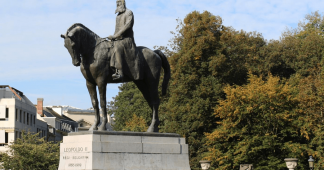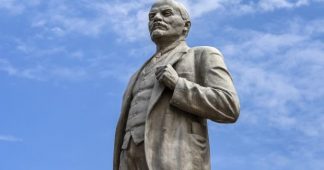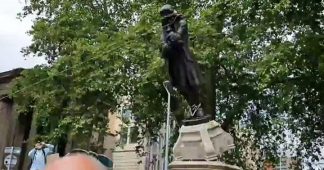The removal of Jefferson’s statue is a gift to the political right
New York City will remove from City Hall a nearly two-hundred-year-old statue of Thomas Jefferson, allegedly on the grounds that the author of the immortal phrase, “We hold these truths to be self-evident, that all men are created equal,” owned slaves.
The removal of the Jefferson statue was ratified unanimously Monday afternoon at a hastily scheduled hearing of an 11-person committee called the Public Design Commission. The hitherto obscure committee is hand-picked and appointed by Mayor Bill de Blasio.
The so-called “hearing” was a sham. The decision had already been taken. A wooden crate had even been constructed especially for the purpose of remanding Jefferson to the New York Historical Society “on long term loan,” an Orwellian expression for mothballing. The Commission did not formally commit to that destination at its Monday hearing, and there are also calls to junk the sculpture outright. “I think it should be put in storage somewhere, destroyed or whatever,” said Democratic State Assemblyman Charles Barron in testimony to the commission.
The Jefferson statue, which has stood at New York City Hall since 1834, is the original plaster model used for the bronze sculpture Thomas Jefferson in the Capitol Rotunda, in Washington D.C., created by the world-renowned French sculptor, David D’Angers (1788-1856). Both statues were donated to the American people by Uriah Phillips Levy (1792-1862), the country’s first Jewish naval officer. With his gifts, Levy wished to recognize Jefferson, who had died seven years earlier, for his role in preventing the establishment of a state religion in the young republic.
A government web site describes the sculpture, which sums up in artistic form Jefferson’s greatest achievement:
“Thomas Jefferson is depicted in his best known role as author of the Declaration of Independence. He stands in a dynamic contrapposto pose with his right hand holding a quill pen. The pen’s tip points to Jefferson’s left hand, which holds the Declaration of Independence. Jefferson’s famous words, which are readable, were created by pressing type into the statue’s clay model. Two bound books—perhaps representing the collection that he donated to the Library of Congress—and a wreath, a symbol of victory, lie at his feet. The statue’s pedestal is composed of marble and granite, in contrasting colors. The front inscription reads “JEFFERSON.””
New York City’s Democratic Party has been moving against the Jefferson statue for some time. Barron first raised the proposal as a city council member in 2001. In 2019, the Black, Latino and Asian Caucus, which comprises about half the city council, put forward the reactionary claim that the author of the Declaration of Independence “symbolizes the disgusting and racist basis on which America was founded.” Then, in June 2020, de Blasio launched a Commission on Racial Justice and Reconciliation tasked with considering the removal of “offensive” monuments, including those to Jefferson and George Washington.
But the New York Democrats are only following the cue from the national party leadership and its leading news organ, the New York Times. In 2019, the Times rolled out its 1619 Project, which promotes the lie that the American Revolution was a counterrevolutionary plot waged to defend slavery against the British Empire. The Democratic Party, joined by leading corporations, ramped up the attack on the American Revolution in response to nationwide demonstrations against state violence that erupted after the police murder of George Floyd in Minneapolis on May 25, 2020, primarily by equating Jefferson and Washington with the southern insurrectionists who launched the Civil War in 1861.
It is not accidental that the attack on Jefferson, the figure most closely associated with equality in American history, comes in the midst of a pandemic that has killed 750,000 Americans and a gathering strike wave emerging in the working class. The Democrats’ aim is to divert social anger into a “racial reckoning” that leaves untouched capitalism and the staggering social inequality it upholds.
It must be stressed that this is not an attack on Jefferson the individual, who has been dead for 195 years and will not be disturbed by the machination of de Blasio and the New York Democrats. It is an attack on the principles that Jefferson represented, above all else the Declaration of Independence’s proclamation of universal human equality. In this sense, the attack on Jefferson only undermines the foundations on which the defense of democracy depends in the face of the growing threat of fascism, while simultaneously providing political cover for Trump and the Republican Party, who posture as the defenders of the legacy of 1776, even as they plot democracy’s overthrow.
As historian Sean Wilentz put in a comment submitted to Monday’s hearing, “To disown Jefferson now, with despotism on the rise in our country as never before in our lifetimes, would be a symbolic blow, especially to the most vulnerable among us, for whom Jefferson’s cry of equality remains the last best hope.”
The racialist “interpretation” finds nothing particularly edifying in the study of history. It reduces history to a morality play in which the dramatis personae are placed into good and bad roles based on the standards of the present. An event as enormously important as the American Revolution had huge causes, and even bigger effects. But in the hands of the racialists, all facets of the broad sweep of history—the intellectual, political, cultural, social, and economic—are cut out, replaced by an appraisal of the personal shortcomings of the individual. If the historical actor in question fails to meet their selective subjective criteria, then he or she is to be denounced.
“Jefferson embodies some of the most shameful parts of our country’s history,” said Adrienne Adams, a councilwoman from Queens at Monday’s hearing. For his part, Barron has repeatedly called Jefferson a “slaveholding pedophile,” because he had a lifelong relationship with one of his slaves, Sally Hemings. Other council members said that Jefferson’s statue made them feel “uncomfortable.” De Blasio, struggling to find the right words, said that Jefferson “profoundly bothers people.”
The New York Times, predictably enough, joined in. In an editorial disguised as a news article, it wrote approvingly of the removal, portraying it as “part of a broad, nationwide reckoning over racial inequality” connected to the “debate over whether Confederate monuments should be toppled and discarded.” After grotesquely implying an identity between the Revolution of 1776 and the Confederate counterrevolution of 1861, the Times lent credence to the portrayal of Jefferson as a mere hypocrite, stating that while he “wrote about equality in the Declaration of Independence, he enslaved more than 600 people and fathered six children with one of them, Sally Hemings.” [emphasis added]
Jefferson did more than “write about equality.” The Declaration’s last phrase, “We Mutually Pledge To Each Other Our Lives, Our Fortunes, And Our Sacred Honor,” was not a mere rhetorical flourish. Jefferson and the other signatories knew they were signing their own death warrants should the revolution fail. Benjamin Franklin meant it when he said, “We must all hang together, or, most assuredly, we shall all hang separately.” The well-heeled editors and the writers of the Times have never risked anything.
In any case, had Jefferson done nothing else in his life but “write about equality” in the Declaration of Independence—at the ripe old age of 33—this alone would establish him as a figure of world-historic stature. It is among the most powerful revolutionary manifestos ever written. The preamble’s simple but audacious assertion of equality must surely rank as the most famous sentence in the history of American letters. This is true not only because of its style, but because it revealed to a “candid world” something that had been hidden in plain sight: the “self-evident truth, that all men are created equal.”
The revolutionary content of this statement rests, then as now, in its objective truth. All people are indeed created equal. The Declaration’s proclamation of human equality, which emerged out of the Enlightenment and was asserted in the context of an insurrectionary war against the British crown, has torn through subsequent American and world history with terrible force. “Equality” has been inscribed on the banner of every subsequent progressive cause, including by the French and Haitian revolutions of 1789 and 1791, the socialist movement, and every anticolonial struggle the world over. In America, the Declaration has been invoked by the abolitionists and Frederick Douglass; the civil rights movement and Martin Luther King, Jr.; the women’s suffrage movement; the labor movement; and today by the life-and-death struggle of the working class for its own political independence. Not a single step forward can be taken that does not begin from the premise that human beings are equal.
Jefferson embodied the contradictions of his time. Universal human equality was unknown when he was born in colonial Virginia in 1743, the child of a slaveholding family. It was a world that, as historian Peter Kolchin put it, “took for granted natural human inequality and the routine use of force necessary to maintain it.” The ancient institution of slavery did not arouse any considerable opposition prior to the Revolution. As Gordon Wood has explained, it was seen as a particularly debased form of exploitation in an age that still depended on various kinds of “unfree labor,” including chattel slavery throughout the Atlantic world, indentured servitude in the northern colonies, and serfdom in Russia.
The American Revolution raised the problem of slavery for the first time as a fundamental political problem. The founding fathers recognized that slavery contradicted their assertion of equality. They even took some measures against it, including the exclusion of slavery from the northwestern territories acquired in the victory over Britain and the banning of the transatlantic slave trade—measures both associated with Jefferson.
The exhilaration of the revolution made a great many believe that slavery would end. Jefferson could say in 1781 that he hoped for “a total emancipation, and that this is disposed, in the order of events, to be with the consent of the masters, rather than by their extirpation.” But neither he nor the southern planters, as a class, could extricate themselves from dependency on slavery. This conforms to historical law. Social classes do not relinquish the bases of their wealth, nor do they voluntarily exit the stage of history. Fed by the bonanza of slave-based cotton production, the slaveowners went from condemning slavery as a “necessary evil” that they hoped would wither away, in the days of Washington and Jefferson, to embracing it as a “positive good” in the days of John C. Calhoun, a half century later. Jefferson did not live to see his fears realized. The masters, as a class, were ultimately “extirpated” in the Civil War.
But while Jefferson, as a slaveowner, was a forerunner of the masters vanquished in the Second American Revolution of the 1860s, his greater, even overriding, contribution was to the cause of freedom, as Calhoun and the other fire-eating advocates of slavery recognized. They condemned Jefferson as a hypocrite and the Declaration of Independence as a lie, just as the Democrats of the present do. Lincoln also knew that Jefferson’s legacy was on the side of freedom, as he said so well at the dedication of the national cemetery to the Union dead at Gettysburg, in 1863:
“Four score and seven years ago our fathers brought forth on this continent, a new nation, conceived in Liberty, and dedicated to the proposition that all men are created equal. Now we are engaged in a great civil war, testing whether that nation, or any nation so conceived and so dedicated, can long endure…”
In any case, Jefferson is not remarkable because he was a slaveowner—there were many thousands of masters in American history—but in spite of that fact. He may well have been the most outstanding figure in a generation that also produced Washington, Franklin, Adams, Madison, Paine, Rush and Hamilton, to name a few. Together with Tom Paine he represented the far-left wing of the American Revolution. Jefferson was the first ambassador to France and there contributed to the drafting of the Declaration of the Rights of Man and of the Citizen. With Madison, he created the “wall of separation” doctrine detaching church from state and pushed for a Bill of Rights to the American Constitution. Like Franklin, his only equal as a figure of the American Enlightenment, Jefferson was a man of science as well as letters, the founder of the Library of Congress and the University of Virginia.
There can be little doubt that he was the most intellectually gifted of all the American presidents. John Kennedy hardly exaggerated when he told a gathering of Nobel laureates in 1962 that it was “the most extraordinary collection of talent, of human knowledge, that has ever been gathered together at the White House, with the possible exception of when Thomas Jefferson dined alone.”
The American ruling class produces no one today that can occupy even the tiniest speck of Jefferson’s shadow. Not the New York City Democrats who serve the city’s billionaires while promoting racial division in the working class. Not the careerist political hack Bill de Blasio, who has neither an original thought nor a political principle in his brain. Not 1619 Project creator Nikole Hannah-Jones, who is willing to accept sponsorship from the oil firm drenched in the blood of Africa, Royal Dutch Shell. And certainly not Barack Obama, who as president oversaw the greatest transfer of wealth to the rich in American history and arrogated to the White House the “right” to assassinate anyone anywhere on the president’s say-so.
In the end, what the American ruling class hates about Jefferson is what distinguishes him most: his authorship of the Declaration of Independence, the very subject of the D’Angers statue. They hate not only the Declaration’s assertion of equality, but its insistence on the right of people to revolution. Governments, Jefferson said, derive “their just powers from the consent of the governed…[W]hen a long train of abuses and usurpations, pursuing invariably the same Object evinces a design to reduce them under absolute Despotism, it is their right, it is their duty, to throw off such Government, and to provide new Guards for their future security.”
The American ruling class of 2021 cannot forgive Jefferson’s assertion of human equality and the right to revolution under conditions in which one million Americans have been sacrificed at the altar of profit, “excess deaths” to the COVID-19 pandemic; and in a city, New York, where 99 billionaires hoard wealth that would have put the Hanover and Capetian dynasties of old England and France to shame, and in which 1.1 million men, women, and children do not have enough to eat. This is the New York that would remove the memory of Thomas Jefferson.
For the working class, it is another matter. Jefferson is not an idol, but a contributor to the revolutionary patrimony which it alone upholds. The movement of workers into struggle and the revival of genuine left-wing politics, processes that are already underway, will see the restoration of Thomas Jefferson to his rightful place in world history
Published at www.wsws.org
We remind our readers that publication of articles on our site does not mean that we agree with what is written. Our policy is to publish anything which we consider of interest, so as to assist our readers in forming their opinions. Sometimes we even publish articles with which we totally disagree, since we believe it is important for our readers to be informed on as wide a spectrum of views as possible.











